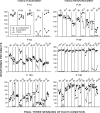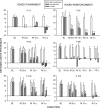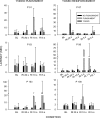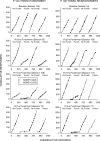Human responding on random-interval schedules of response-cost punishment: the role of reduced reinforcement density
- PMID: 20676265
- PMCID: PMC2801542
- DOI: 10.1901/jeab.2010.93-5
Human responding on random-interval schedules of response-cost punishment: the role of reduced reinforcement density
Abstract
An experiment with adult humans investigated the effects of response-contingent money loss (response-cost punishment) on monetary-reinforced responding. A yoked-control procedure was used to separate the effects on responding of the response-cost contingency from the effects of reduced reinforcement density. Eight adults pressed buttons for money on a three-component multiple reinforcement schedule. During baseline, responding in all components produced money gains according to a random-interval 20-s schedule. During punishment conditions, responding during the punishment component conjointly produced money losses according to a random-interval schedule. The value of the response-cost schedule was manipulated across conditions to systematically evaluate the effects on responding of response-cost frequency. Participants were assigned to one of two yoked-control conditions. For participants in the Yoked Punishment group, during punishment conditions money losses were delivered in the yoked component response independently at the same intervals that money losses were produced in the punishment component. For participants in the Yoked Reinforcement group, responding in the yoked component produced the same net earnings as produced in the punishment component. In 6 of 8 participants, contingent response cost selectively decreased response rates in the punishment component and the magnitude of the decrease was directly related to the punishment schedule value. Under punishment conditions, for participants in the Yoked Punishment group response rates in the yoked component also decreased, but the decrease was less than that observed in the punishment component, whereas for participants in the Yoked Reinforcement group response rates in the yoked component remained similar to rates in the no-punishment component. These results provide further evidence that contingent response cost functions similarly to noxious punishers in that it appears to suppress responding apart from its effects on reinforcement density.
Keywords: humans; random-interval schedules; response-cost punishment; response-independent punishment; yoked-control procedure.
Figures







Similar articles
-
Response-cost punishment via token loss with pigeons.Behav Processes. 2005 Jun 30;69(3):343-56. doi: 10.1016/j.beproc.2005.02.026. Epub 2005 Mar 28. Behav Processes. 2005. PMID: 15896532
-
Response-cost punishment with pigeons: further evidence of response suppression via token loss.Learn Behav. 2008 Feb;36(1):29-41. doi: 10.3758/lb.36.1.29. Learn Behav. 2008. PMID: 18318424
-
Effect of variable-interval punishment on the behavior of humans in variable-interval schedules of monetary reinforcement.J Exp Anal Behav. 1978 Mar;29(2):161-6. doi: 10.1901/jeab.1978.29-161. J Exp Anal Behav. 1978. PMID: 16812044 Free PMC article.
-
The effects of simultaneous point gains and losses on human persistence.J Exp Anal Behav. 2025 Mar;123(2):117-138. doi: 10.1002/jeab.4228. Epub 2024 Nov 19. J Exp Anal Behav. 2025. PMID: 39559957
-
The several roles of stimuli in token reinforcement.J Exp Anal Behav. 2015 Mar;103(2):269-87. doi: 10.1002/jeab.117. Epub 2015 Jan 20. J Exp Anal Behav. 2015. PMID: 25604188
Cited by
-
Evaluating Extinction, Renewal, and Resurgence of Operant Behavior in Humans with Amazon Mechanical Turk.Learn Motiv. 2021 May;74:101728. doi: 10.1016/j.lmot.2021.101728. Epub 2021 May 13. Learn Motiv. 2021. PMID: 34149066 Free PMC article.
-
Loss Aversion Reflects Information Accumulation, Not Bias: A Drift-Diffusion Model Study.Front Psychol. 2017 Oct 10;8:1708. doi: 10.3389/fpsyg.2017.01708. eCollection 2017. Front Psychol. 2017. PMID: 29066987 Free PMC article.
References
-
- Azrin N.H. Some effects of two intermittent schedules of immediate and non-immediate punishment. The Journal of Psychology. 1956;42:3–21.
-
- Azrin N.H, Holz W.C. Punishment. In: Honig W.K, editor. Operant behavior: Areas of research and applications. New York: Appleton-Century-Crofts; 1966. pp. 380–447.
-
- Banks R.K. Persistence to continuous punishment following intermittent punishment training. Journal of Experimental Psychology. 1966;71:373–377. - PubMed
Publication types
MeSH terms
LinkOut - more resources
Full Text Sources

